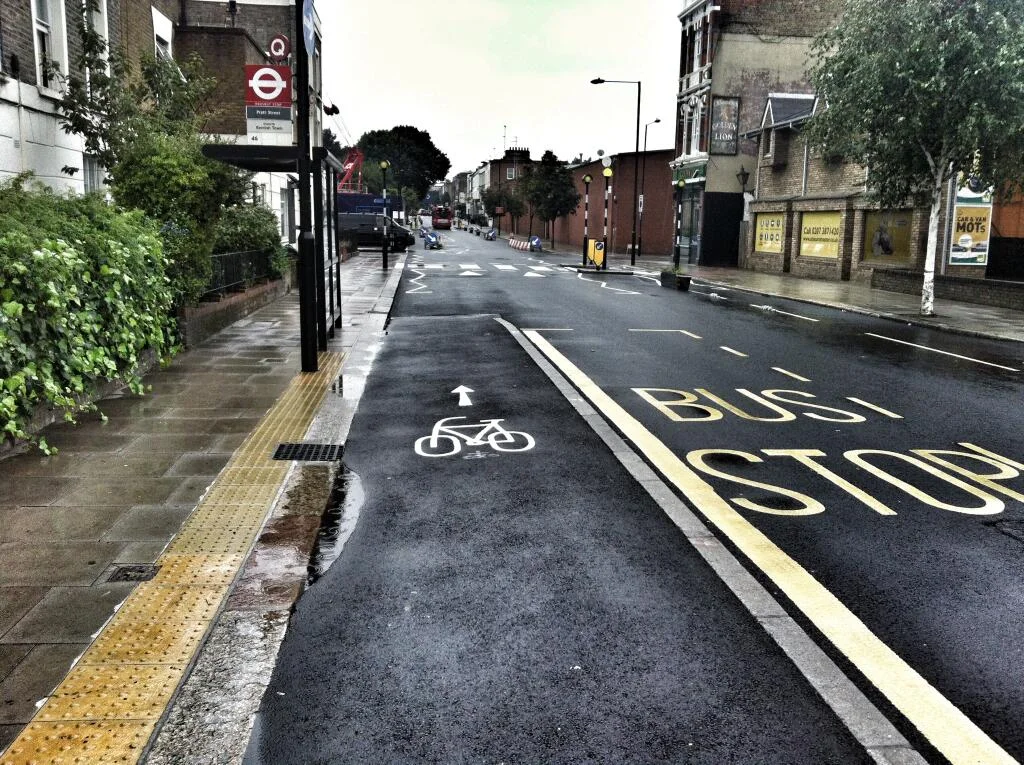Riding home a few nights ago, I hit a section of segregated cycle path along Royal College Street in Camden Town. I was pretty impressed.
The two-metre wide tracks give the cyclist space to breathe and, unlike the shitty uni-directional paths in Bloomsbury, they don't leave the cyclist at risk of a head-on. While not infrastructurally (I'm making up words now) segregated like those in Denmark and the Netherlands (if only...), the planter boxes between the path and the road really do add to the aesthetics of the streetscape. When the cycle ways meet the bus stops that are lined along the street, they continue nicely along the inside of the road.
This is a nice improvement from the Cycle Superhighways, where cyclists are suddenly forced into outside lanes when buses stop. It's also a nice improvement on this in Bethnal Green (whatever, that cycle "path" is... I tend to just avoid for my own safety).
Additionally, down in Shoreditch we've got some beautiful new bike racks installed by Cyclehoop and Hackney Council. Each replacing an on-street car space, the car-shaped racks each have engraved, "1 car = 10 bikes". Pretty cool.
New bike shit in London!? This is all great, right?
Yes and no.
There are two problems here. Firstly, while these new infrastructure investments are ok, they're not great. As Mark at Bicycle Dutch has correctly pointed out, the bus stops on Royal College Street in Camden Town could have very easily been implemented with at least a small pedestrian island to avoid conflict between cyclists and bus passengers when getting on and off the bus. The importance of these pedestrian islands can be seen in this short film.
Similarly, while Hackney's new bike racks are great, they're only temporary and they've been thrown into East London's most obscure back streets. Hackney Council: step it up. Install these on your high streets where they're meant to be.
London has a tendency to deliver at the status quo, or just slightly above it. When all the consultation process is done and dusted, planners realise that they can only do slightly better than what has been done before, or else they'll piss too many people off. These are the woes of democratic planning systems. The problem is however, a lot of cyclists are getting seriously hurt on our roads in the mean time. People are dying in order to save car spaces.
My second point. London has a history of implementing cycling infrastructure in a super ad-hoc and fragmented manner, rather than thinking strategically. There are a lot of problems with this... What's the point of having different types of cycle paths designs all across the city?
What's the point of having one street segregated, but the next street mixed with HGVs, pot holes and 50 m/ph traffic? Everyday commuters are not going to get on their bike, if the cycle path will only take them to to the end of their road.
Now, this isn't necessarily Camden and Hackney's fault, but this is something that these councils can change. Cycling infrastructure in London needs a strategic and coherent vision in order for commuters to lose their fear of the road. While these improvements are ok, they're not improving network or design consistency. In a sense, they're doing the opposite.
I'm sorry to come across as all negative about these developments. But if London actually wants to hit its cycling targets, it needs to raise the bar. And it needs to raise this bar right across the city. People need confidence in a system that works.
The last thing we need right now is a bus passenger to get off a bus on Royal College Street and be taken out by a bike. That publicity won't do any favours for the cause of the cyclists, or the councils. Let's just do it right in the first place.
Feature image: Royal College Street, Camden, London. Photo by Tom Payne












